Growing blue passionflower and caring for it at home
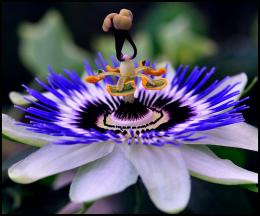
Blue passionflower is an evergreen liana-like plant belonging to the passionflower family. Other names: blue passionflower, Cavalier star. This plant is native to Brazil, Argentina, Paraguay, and Uruguay.
Content:
Description of the plant
Blue passionflower is widespread in indoor floriculture. In addition to its decorative function, the medicinal properties of this plant are known, and the fruits are sometimes used in cooking. What does it represent?
Blue passionflower can reach 10 meters in length. Its shoots are quite thin, with leaves arranged alternately on the petioles. The internodes are long, and from the nodes, in addition to the leaves, tightly twisted tendrils grow, with the help of which the plant is fixed on a vertical or slightly inclined plane and can move upward along it as it grows.
The leaves of blue passionflower are round, palmately dissected into approximately 6 segments. The upper side of the leaf is a glossy dark green shade, while the lower side is matte and rough to the touch.
Flowering time - from spring to autumn. The flowers are large with a strong aroma, appear in the axils of the leaves and fall off within a day. New ones appear in their place.
The name “Cavalier Star” was given precisely for the appearance of the flowers of this plant: 5 white-blue sepals open in the shape of a star, 5 of the same petals are superimposed on them. The middle is framed by thick tricolor threads, 5 bright yellow star-shaped stamens rise above them, and a burgundy pistil completes this composition.
Starting in autumn, the plant bears fruit. The fruits are quite large, orange, covered with a thick skin. Underneath it lies many seeds covered with a watery red shell. The fruits are edible, but have no taste.
How to care for blue passionflower?
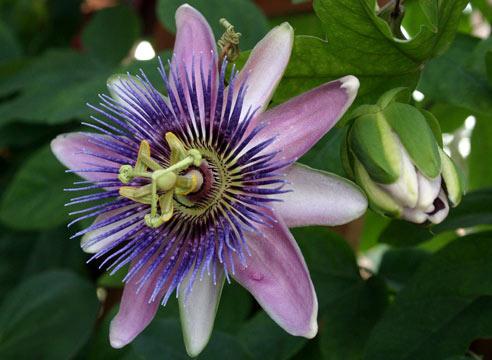
Lighting
Blue passionflower loves bright direct rays of the sun, but is also desirable increased air humidity and sufficiently moist soil. In spring and summer, a good option for this plant would be to move it to an open balcony or garden in a well-lit area.
If it is not possible to take the plant out, then it should be placed in the room near a south-facing window, providing an influx of fresh air.
It is necessary to gradually accustom passionflower to a different level of lighting and direct sunlight. Unprepared exposure of leaves to direct sunlight can cause sunburn.
In the autumn-winter period, you should provide additional lighting for this plant and artificially extend its daylight hours to 12 hours. Additional lighting may be required in summer if the plant can only be placed near a window on the shady side.
Air temperature and humidity
- From spring to late autumn, passionflower feels most comfortable at temperatures from 20 to 26 degrees.From time to time you need to spray the plant with water at room temperature; the water must first settle well.
- To increase humidity, you can also place passionflower in a tray with wet expanded clay or pebbles. If the air humidity in the room is low, the buds may fall off, and spider mites may appear on the leaves.
- In winter, blue passionflower needs to provide conditions for rest. Therefore, the temperature in the room where the plant is located should be kept in the range of 14-18 degrees. In winter, the plant is also sprayed with water when the air is dry.
Watering and fertilizing
The soil in the pot where blue passionflower is planted should always be slightly moist. It should not be allowed to dry out. Therefore, watering is carried out as needed, when the top layer of the substrate begins to dry out.
But too frequent watering, which will lead to stagnation of water, is unacceptable. When caring for this plant, it is very important to maintain a balance in watering; its violation often leads to disease and death of passionflower.
In winter, the plant is watered infrequently, but watering is not stopped at all. Once a week or two weeks, the plant must be fed with any complex fertilizer suitable for vines. In winter, fertilizing passionflower is not required.
Reproduction
Passiflora blue very good propagated by cuttings. They are cut off from the main plant, choosing a length so that it contains at least a couple of internodes. It is better to disinfect the cuttings to avoid rotting, and then sprinkle them with wood ash:
- The soil for planting cuttings should consist of half sand. To root a cutting, you need both warm air and warm soil.Therefore, it is better to use special heated greenhouses. The rules for caring for cuttings are the same as for an adult plant.
- Placing the cuttings in a container of water gives good results. It must be placed in a place with bright lighting. After a month, the plant can be transplanted into nutrient soil.
- Cuttings are carried out in March-April before active growth begins. After a year, the plant grown from the cuttings may already bloom.
- You can grow blue passionflower from seeds. In this case, you should study the instructions on the package.
Transfer
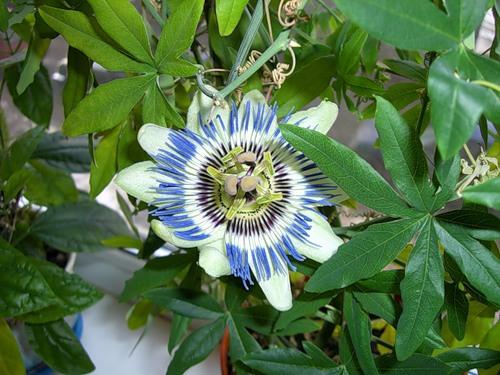
Blue passionflower can grow to large sizes if you increase the volume of the container for it when replanting. If you don’t want to end up with a ten-meter vine, then you need to replant the plant in a small pot, approximately the same as the previous one. The roots will take up as much space as you give them. This will not affect bloom passionflower, of course, with proper care.
Passionflower is transplanted once every two or three years in March or early April and combined with shortening the shoots. If your plant lives in a large pot, then instead of replanting it is enough to replace the top layer of soil (up to 5 cm) with a new one.
Features of cultivation
For blue passionflower, a support is needed for the plant to hold on to with the help of its mustache. It should be borne in mind that the mustache is twisted so tightly that it is impossible to move it.
Passion flowers should not be heavily or frequently pruned. Such actions can weaken it and lead to illness. When cutting shoots, the distance to the main stem should remain about 4 cm.
Insufficiently high temperature and humidity, poor lighting and lack of fertilizing lead to slow growth and a small number of flowers. When temperature changes, passionflower can lose all its leaves.
Sometimes, for physiological reasons, almost half of the fruits fall off before they ripen.
Passiflora blue – highly ornamental plant. It is suitable for landscaping a room, but due to the large size of an adult plant and rapid growth, it becomes cramped in the window space. Its decorative qualities are fully manifested when landscaping spacious rooms: balconies, winter gardens, lobbies.
Watch all about blue passionflower in the video:
Interesting information about the vegetable garden

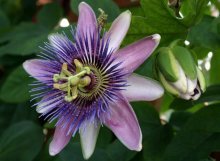
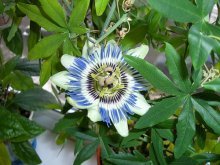
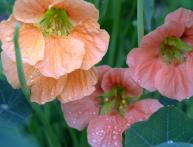

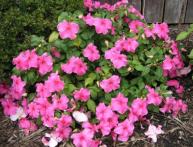
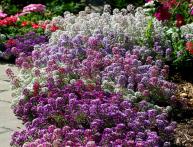
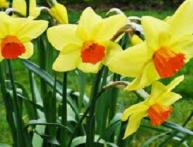


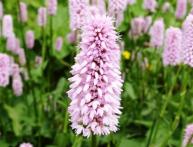
Comments
A very beautiful plant. It is a pity that it is quite demanding in care - there is not always time to look after the plants. I only keep pets at home that don't require much care.